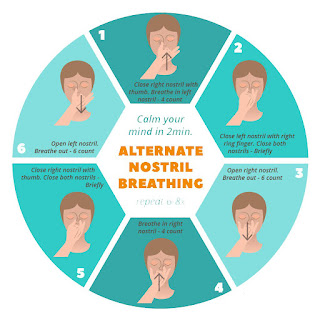One of the key elements of yoga is breathing exercises; in fact, many claim breathing techniques called pranayama form the foundation of yoga as one of its eight pillars, along with asanas (exercises), meditation. Pranayama is derived from Sanskrit words, prana meaning "life force" and yama meaning "control." So essentially it means controlling your life force. (More on the life force concept to follow, but I also covered it in a previous post which can be found at https://ancientmedicina.blogspot.com/2020/09/vital-energy-in-ancient-medicine.html)
One of the pranayama exercises used in yoga is called Nadi Shodhana which means purification of the channel or flow in Sanskrit. It requires timed deep inhaling and exhaling from alternate nostrils repeatedly. While pranayama is common practice for anyone with knowledge of yoga (including my family), what is not widely known is the real medical benefits of this breathing technique. Many people do it because it is part of the exercise ritual while others simply skip it. However, it is also common knowledge that deep breathing can be relaxing and there is ample evidence that deep breathing can relieve stress and anxiety, improve focus and help control emotions (comes in handy during a panic attack).
 |
| Pranayama breathing technique |
But now modern researchers have uncovered that the specific breathing technique in yoga has medical benefits for the heart. It is a different matter that they gave it a western name: cardiac coherence breathing exercise. The study was published in Scientific American journal with results showing that the alternate-nostril breathing technique (which is identical to Nada Shodhana pranayama) stabilized the heartbeat. It caused quite an uproar in the Indian American community, who accused western scientists of cultural appropriation and rebranding an ancient Indian technique.
Controversy on the name aside, what is important is that the deep breathing exercise that has been practiced by Indian yogis for several millennia and more recently by many westerners was found to have a direct effect on the heart, which also explains its calming effect on anxiety. In addition to the psychological aspect of calming anxiety, it has a physiological effect because it stimulates the parasympathetic nervous system (specifically the vagus nerve that controls the activity of many internal organs). This results in the slowing down of the heart rate to regular, decrease in blood pressure, and relaxation of muscles, allowing an overall reduction of anxiety and helping insomnia.
So once again, lessons from ancient medicine are being rediscovered and retaught, but this time with scientific evidence, which according to me is a critical aspect of medicine. Instead of being upset with scientists for publishing research on ancient medical techniques, we should applaud them for bringing it back with solid evidence of its benefits (giving it a new name is still up for argument though!)
The technique (which I must admit I did not know before this) is quite simple and something I am going to try out when I feel my stress level increasing. The picture below gives a simple tutorial for those of you wanting to give it a try.
Sources:
https://twitter.com/sciam/status/1089538576222699521?lang=en

Comments
Post a Comment